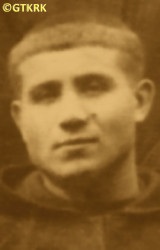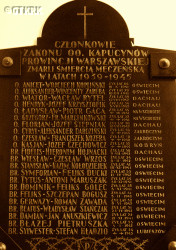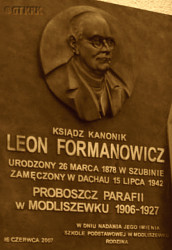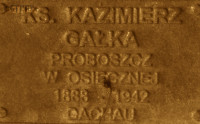Roman Catholic
St Sigismund parish
05-507 Słomczyn
85 Wiślana Str.
Konstancin deanery
Warsaw archdiocese, Poland
full list:
displayClick to display full list

searchClick to search full list by categories
wyświetlKliknij by wyświetlić pełną listę po polsku

szukajKliknij by przeszukać listę wg kategorii po polsku

Martyrology of the clergy — Poland
XX century (1914 – 1989)
personal data
surname
CZECHOWICZ
forename(s)
Joseph (pl. Józef)
religious forename(s)
Cassian (pl. Kasjan)
function
religious cleric
creed
Byzantine–Slavic Catholic Church BSmore on
pl.wikipedia.org
[access: 2013.01.13]
congregation
Order of Capuchin Friars Minor OFMCapmore on
en.wikipedia.org
[access: 2013.05.19]
(i.e. Capuchins)
diocese / province
Warsaw province OFMcapmore on
www.kapucyni.pl
[access: 2014.08.18]
date and place
of death
06.1943

Koveltoday: Kovel urban hrom., Kovel rai., Volyn obl., Ukraine
more on
en.wikipedia.org
[access: 2021.12.19]
alt. dates and places
of death
10.12.1943
details of death
After German and Russian invasion of Poland in 09.1939 and start of the World War II, after start of Russian occupation, Russians forced his Lubeshev monastery to reduce its activities to minimum.
Despite of that prob. remained there though most of the friars left monastery.
After German attack on 22.06.1941 of their erstwhile ally, Russians, and start of German occupation, during «Genocidium Atrox» — the genocide perpetrated by Ukrainians, known as „Volyn genocide” — moved to a nearby Gorodnaya town, in Belarus.
There supported the efforts of local Eastern rite parish.
When the attacks of the genocidal Ukrainian nationalist organization OUN/UPA became commonplace decided to go to the headquarters of the local UPA unit to ask for a cessation of murders of Poles.
Arrested instead and brought to Kovel where was drowned in the well or dropped from a bridge over Styr (Turia?) river.
A quote from the monastic Mortuology states: „On the bridge spanning the river, an execution took place among a large crowd: throwing into the Styr River. A cloak and a cap were hung on the bridge railing”.
cause of death
murder
perpetrators
Ukrainians
sites and events
«Genocidium Atrox»Click to display the description, Ribbentrop‐MolotovClick to display the description
date and place
of birth
16.01.1912Birth certification on:
www.familysearch.org
[access: 2025.10.15]

Białaczówtoday: Białaczów gm., Opoczno pov., Łódź voiv., Poland
more on
en.wikipedia.org
[access: 2021.09.29]
parents
CZECHOWICZ Francis
🞲 ?, ? — 🕆 ?, ?

PODLEWSKA Catherine
🞲 ?, ? — 🕆 ?, ?
baptism
19.01.1912Birth certification on:
www.familysearch.org
[access: 2025.10.15]

Białaczówtoday: Białaczów gm., Opoczno pov., Łódź voiv., Poland
more on
en.wikipedia.org
[access: 2021.09.29]
St John the Baptist RC church
religious vows
15.08.1931 (temporary)
15.08.1934 (permanent)
presbyter (holy orders)
ordination
11.07.1937

Lublintoday: Lublin city pov., Lublin voiv., Poland
more on
en.wikipedia.org
[access: 2021.08.20]
positions held
c. 1941 – 1943
priest — Gorodnayatoday: Horodno ssov., Stolin dist., Brest reg., Belarus
more on
be.wikipedia.org
[access: 2022.11.12] ⋄ Holy Trinity BS parish ⋄ Stolintoday: Stolin dist., Brest reg., Belarus
more on
en.wikipedia.org
[access: 2022.05.02] BS deanery
1938 – c. 1941
friar — Liubeshivtoday: Liubeshiv hrom., Kamin‐Kashyrskyi rai., Volyn obl., Ukraine
more on
en.wikipedia.org
[access: 2022.11.12] ⋄ St Ciril and St Methodius monastery, Capuchins OFMCap
till 1938
student — Lublintoday: Lublin city pov., Lublin voiv., Poland
more on
en.wikipedia.org
[access: 2021.08.20] ⋄ Theological Study (higher theological seminary), St Peter and St Paul the Apostles monastery, Capuchins OFMCap — in 1937‐1938 prob. specialised studies in the field of Eastern rite
student — Zakroczymtoday: Zakroczym gm., Nowy Dwór Mazowiecki pov., Masovia voiv., Poland
more on
en.wikipedia.org
[access: 2021.12.18] ⋄ Philosophical Study (higher theological seminary), St Lawrence the Martyr monastery, Capuchins OFMCap
student — Łomżatoday: Łomża city pov., Podlaskie voiv., Poland
more on
en.wikipedia.org
[access: 2022.01.28] ⋄ Philosophical Study (higher theological seminary), Blessed Virgin Mary of Sorrows monastery, Capuchins OFMCap
1930 – 15.08.1931
novitiate — Nowe Miasto nad Pilicątoday: Nowe Miasto nad Pilicą gm., Grójec pov., Masovia voiv., Poland
more on
en.wikipedia.org
[access: 2022.01.28] ⋄ St Casimir the Prince and Confessor monastery, Capuchins OFMCap
14.08.1930
accession — Nowe Miasto nad Pilicątoday: Nowe Miasto nad Pilicą gm., Grójec pov., Masovia voiv., Poland
more on
en.wikipedia.org
[access: 2022.01.28] ⋄ St Casimir the Prince and Confessor monastery, Capuchins OFMCap
others related
in death
BORRELClick to display biography John (Fr of the Incarnation), GANOClick to display biography Hedwig (Sr Mary Aloysia), HŁADZIOClick to display biography Steven (Bro. Silvester), OSSAKOWSKAClick to display biography Mary (Sr Andrea)
sites and events
descriptions
«Genocidium Atrox»: In 1939‐1947, especially in 1943‐1944, independent Ukrainian units, mainly belonging to genocidal Ukrainian organizations OUN (political arm) and UPA (military arm), supported by local Ukrainian population, murdered — often in extremely brutal way — in Volyn and surrounding regions of pre‐war Poland, from 130,000 to 180,000 Poles, all civilians: men, women, children, old and young. Polish‐Ukrainian conflict that openly emerged during and after World War I (in particular resulting in Polish‐Ukrainian war of 1918‐1919), that survived and even deepened later when western Ukraine became a part Poland, exploded again after the outbreak of the World War II in 09.1939. During Russian occupation of 1939‐1941, when hundreds of thousands of Poles were deported into central Russia, when tens of thousands were murdered (during so‐called Katyń massacres, among others), this open conflict had a limited character, helped by the fact that at that time Ukrainians, Ukrainian nationalists in particular, were also persecuted by the Russians. The worst came after German‐Russian war started on 22.06.1941 and German occupation resulted. Initially Ukrainians supported Germans (Ukrainian police was initiated, Ukrainians co—participated in extermination of the Jews and were joining army units fighting alongside Germans). Later when German ambivalent position towards Ukraine became apparent Ukrainians started acting independently. And in 1943 one of the units of aforementioned Ukrainian OUN/UPA organization, in Volyn, started and perpetrated a genocide of Polish population of this region. In mere few weeks OUN/UPA murdered, with Germans passively watching on the sidelines, more than 40,000 Poles. This strategy was consequently approved and adopted by all OUN/UPA organisations and similar genocides took place in Eastern Lesser Poland (part of Ukraine) where more than 20,000 Poles were slaughtered, meeting however with growing resistance from Polish population. Further west, in Chełm, Rzeszów, etc. regions this genocide turned into an extremely bloody conflict. In general genocide, perpetrated by Ukrainian nationalists, partly collaborating with German occupants, on vulnerable Polish population took part in hundreds of villages and small towns, where virtually all Polish inhabitants were wiped out. More than 200 priests, religious and nuns perished in this holocaust — known as «Genocidium Atrox» (Eng. „savage genocide”) The nature and purpose of genocide is perhaps best reflected in the song sung by the murderers: „We will slaughter the Poles, we will cut down the Jews, we must conquer the great Ukraine” (ukr. „Поляків виріжем, Євреїв видусим, велику Україну здобути мусим”). This holocaust and conflict ended up in total elimination of Polish population and Polish culture from Ukraine, in enforced deportations in 1944‐1945 of remaining Poles from Ukraine and some Ukrainians into Ukraine proper, and finally in deportation of Ukrainians from East‐South to the Western parts of Polish republic prl by Commie‐Nazi Russian controlled Polish security forces („Vistula Action”). (more on: www.swzygmunt.knc.plClick to attempt to display webpage
[access: 2021.06.20])
Ribbentrop‐Molotov: Genocidal Russian‐German alliance pact between Russian leader Joseph Stalin and German leader Adolf Hitler signed on 23.08.1939 in Moscow by respective foreign ministers, Mr. Vyacheslav Molotov for Russia and Joachim von Ribbentrop for Germany. The pact sanctioned and was the direct cause of joint Russian and German invasion of Poland and the outbreak of the World War II in 09.1939. In a political sense, the pact was an attempt to restore the status quo ante before 1914, with one exception, namely the „commercial” exchange of the so‐called „Kingdom of Poland”, which in 1914 was part of the Russian Empire, fore Eastern Galicia (today's western Ukraine), in 1914 belonging to the Austro‐Hungarian Empire. Galicia, including Lviv, was to be taken over by the Russians, the „Kingdom of Poland” — under the name of the General Governorate — Germany. The resultant „war was one of the greatest calamities and dramas of humanity in history, for two atheistic and anti‐Christian ideologies — national and international socialism — rejected God and His fifth Decalogue commandment: Thou shall not kill!” (Abp Stanislav Gądecki, 01.09.2019). The decisions taken — backed up by the betrayal of the formal allies of Poland, France and Germany, which on 12.09.1939, at a joint conference in Abbeville, decided not to provide aid to attacked Poland and not to take military action against Germany (a clear breach of treaty obligations with Poland) — were on 28.09.1939 slightly altered and made more precise when a treaty on „German‐Russian boundaries and friendship” was agreed by the same murderous signatories. One of its findings was establishment of spheres of influence in Central and Eastern Europe and in consequence IV partition of Poland. In one of its secret annexes agreed, that: „the Signatories will not tolerate on its respective territories any Polish propaganda that affects the territory of the other Side. On their respective territories they will suppress all such propaganda and inform each other of the measures taken to accomplish it”. The agreements resulted in a series of meeting between two genocidal organization representing both sides — German Gestapo and Russian NKVD when coordination of efforts to exterminate Polish intelligentsia and Polish leading classes (in Germany called «Intelligenzaktion», in Russia took the form of Katyń massacres) where discussed. Resulted in deaths of hundreds of thousands of Polish intelligentsia, including thousands of priests presented here, and tens of millions of ordinary people,. The results of this Russian‐German pact lasted till 1989 and are still in evidence even today. (more on: en.wikipedia.orgClick to attempt to display webpage
[access: 2015.09.30])
sources
personal:
nawolyniu.plClick to attempt to display webpage
[access: 2013.01.06], nawolyniu.plClick to attempt to display webpage
[access: 2013.01.06], www.familysearch.orgClick to attempt to display webpage
[access: 2025.10.15], tomaszowmazowiecki.naszemiasto.plClick to attempt to display webpage
[access: 2013.12.04]
original images:
www.naszeopoczno.plClick to attempt to display webpage
[access: 2013.06.11], www.isakowicz.plClick to attempt to display webpage
[access: 2013.12.04], www.formanowicz.plClick to attempt to display webpage
[access: 2013.06.23]
LETTER to CUSTODIAN/ADMINISTRATOR
If you have an Email client on your communicator/computer — such as Mozilla Thunderbird, Windows Mail or Microsoft Outlook, described at WikipediaPatrz:
en.wikipedia.org, among others — try the link below, please:
LETTER to CUSTODIAN/ADMINISTRATORClick and try to call your own Email client
If however you do not run such a client or the above link is not active please send an email to the Custodian/Administrator using your account — in your customary email/correspondence engine — at the following address:

giving the following as the subject:
MARTYROLOGY: CZECHOWICZ Joseph
To return to the biography press below:
 Click to return to biography
Click to return to biography












